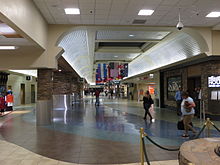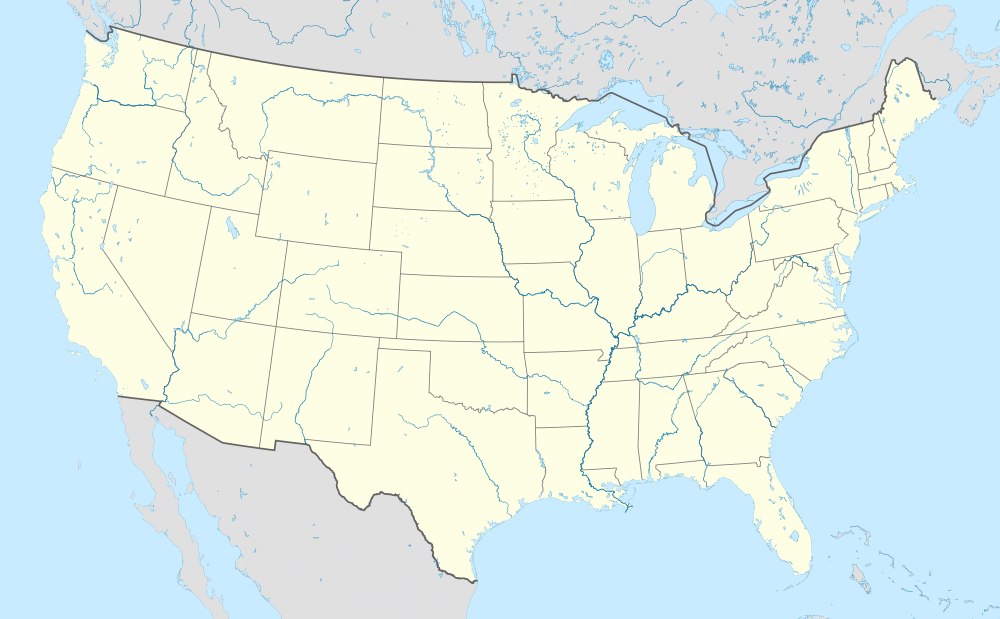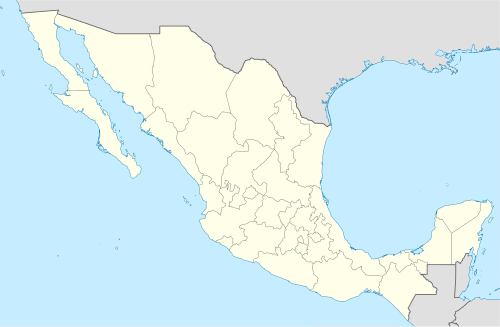Reno–Tahoe International Airport
Reno–Tahoe International Airport | |||||||||||||||||||
|---|---|---|---|---|---|---|---|---|---|---|---|---|---|---|---|---|---|---|---|
 | |||||||||||||||||||
 | |||||||||||||||||||
| Summary | |||||||||||||||||||
| Airport type | Public | ||||||||||||||||||
| Owner/Operator | Reno–Tahoe Airport Authority | ||||||||||||||||||
| Serves | Reno, Nevada | ||||||||||||||||||
| Location | Reno, Nevada | ||||||||||||||||||
| Elevation AMSL | 4,415 ft / 1,346 m | ||||||||||||||||||
| Coordinates | 39°29′57″N 119°46′05″W / 39.49917°N 119.76806°W | ||||||||||||||||||
| Website | www.renoairport.com | ||||||||||||||||||
| Maps | |||||||||||||||||||
 FAA diagram | |||||||||||||||||||
 | |||||||||||||||||||
| Runways | |||||||||||||||||||
| |||||||||||||||||||
| Statistics (2018) | |||||||||||||||||||
| |||||||||||||||||||
Reno–Tahoe International Airport (IATA: RNO, ICAO: KRNO, FAA LID: RNO) is a public/military airport three miles (6 km) southeast of downtown Reno, in Washoe County, Nevada.[1][3] It is the state's second busiest commercial airport after McCarran International Airport in Las Vegas. The Nevada Air National Guard has the 152nd Airlift Wing southwest of the airport's main terminal. It is named after both the City of Reno and Jesse L. Reno and Lake Tahoe.[citation needed]
History
Early years
The airport was built in 1929 by Boeing Transport Inc. and named Hubbard Field after Boeing Air Transport VP and air transport pioneer Eddie Hubbard.[4] It was acquired by United Airlines in 1936 and purchased by the City of Reno in 1953. The August 1953 OAG shows 15 scheduled departures each weekday; ten years later there were 28.
Jets (United 727s) arrived in June 1964; runway 16 (now 16R) was extended southward from 7800 to 9000 feet around that time. The airport didn't rate a nonstop to Los Angeles until 1969; a nonstop to Chicago began in 1970.
The first terminal building was completed in time for the 1960 Winter Olympics held in Squaw Valley, California in 1960. The present ticketing lobby and concourses were built in 1979.[5] The airport received its current name in 1994 (which honors both the city and the nearby popular tourist destination Lake Tahoe), when the terminal was named in honor of retired Air Force Reserve Major General and former U.S. Senator Howard Cannon.[6] Prior to that the airport itself was named Cannon International Airport.
Reno–Tahoe International was the hub of Reno Air, a now-defunct airline that had MD-80s and MD-90s to many cities until it was bought by American Airlines and later disposed of, in 2001. Reno Air's first flight was on July 1, 1992, and its last flight was August 30, 1999. On New Year's Eve of 2003, Continental Airlines completed the installation of self check-in in the continental United States at Reno International.[7]
Expansion
The terminal was remodeled in 1996, 2009 and 2013. In 1996, the baggage claim and ticketing area were updated with technology and decor similar to Las Vegas. In 2008, the Airport began a $70 million project that enhanced the baggage screening equipment and remodeled the ticketing area with a modern Tahoe theme; the project was entirely completed in 2010. To complete the renovations, the TSA ordered the shutdown of the ticketing area, so the airport built a full service heated/a/c temporary ticketing tent, which took up 3 lanes out of 6 in front of the airport for taxi, pick up and drop off. In March 2013, a $24 million expansion of the airport was completed and focused on a new centralized TSA Security Checkpoint on the Ground Level, and above it, a shopping/dining promenade called "High Mountain Marketplace" which consists of CNBC News, InMotion Entertainment, Brighton and No Boundaries Outdoor Apparel. Dining options include McDonald's, Timber Ridge Restaurant, among others in the two concourses. There are giant windows in the dining areas that allow expansive views of the mountains and runways. Leading major airport designers designed the new spaces. With the new security checkpoint, travelers can now access both concourses without having to go through security. Future projects may include updates to the concourses.
The airport celebrated 75 years of service in November 2003.
International service
On February 2014, the airport announced that Volaris planned to start operating non-stop service flights to Guadalajara, Mexico sometime in 2015. Since the DOT approved the route, it is Reno's first international non-stop service since 1999. On October 7, 2014, the DOT and the airport announced that Volaris would start a twice weekly flight to Guadalajara, Mexico from Reno on December 16, 2014.[8]
In November 2014, Thomas Cook Airlines announced that it planned to introduce twice weekly, non-stop flights from London–Gatwick to Reno starting in December 2015. It would have been the first transatlantic route from Reno Airport.[9] However, Thomas Cook Airlines canceled these plans in May 2015 stating insufficient border control capacities at the airport to handle their Airbus A330.[10][11]
Facilities
Overview

Reno/Tahoe International Airport covers 1,450 acres (587 ha) at an elevation of 4,415 feet (1,346 m). In the year ending June 30, 2018 the airport had 93,636 aircraft operations, average 256 per day: 47% airline, 38% general aviation, 13% air taxi, and 3% military. At that time 123 aircraft were based here: 74 single-engine, 18 multi-engine, 17 jet, 9 military, and 5 helicopter.[1] The National Plan of Integrated Airport Systems categorized it as a primary commercial service airport (more than 10,000 enplanements per year).[12]
It has three concrete runways: 16R/34L is 11,001 by 150 feet (3,353 x 46 m); 16L/34R is 9,000 by 150 feet (2,743 x 46 m); 7/25 is 6,102 by 150 feet (1,860 x 46 m).[1] In fall 2010 the airport opened a new 200-foot (61-meter) ATCT to replace the 70-foot (21-meter) control tower that had been used for more than 50 years. It was designed by the Parsons Design Firm, responsible for the design of many other ATCT towers. Cost of the new tower was about 30 million dollars.
The passenger terminal is named after the late US Senator Howard Cannon.[13] The lobby of the terminal has an exhibit with the bust of Nevada State Senator (and Nevada State Senate Minority Leader) William J. "Bill" Raggio. Raggio is described in the exhibit as being "The Father of the Airport Authority."
Military facilities

The airport is also host to Reno Air National Guard Base, an approximately 60-acre (24 ha) complex which was established on the west side of the airport in 1954 when Air National Guard units relocated from the former Stead Air Force Base in Reno.
The base is home to the 152d Airlift Wing (152 AW), a Nevada Air National Guard unit operationally gained by the Air Mobility Command (AMC) and equipped with C-130H Hercules aircraft.
Terminals

Reno–Tahoe International Airport provides two concourses designated B and C with an overall 23 jet bridge gates.
Airlines serving Reno have around 140 flights daily to and from the airport, providing service to 22 cities non-stop and about 31 cities with a same plane one-stop flight. Each terminal used to have its own security area on the concourse level, but were replaced in March 2013 with a combined security area on the first floor for both terminals.
Airlines and destinations
Passenger

| Domestic Destinations map |
|---|
(Red) = Year-round Destination
Cargo
| Airlines | Destinations |
|---|---|
| Ameriflight | Elko, Hayward, Las Vegas, Lovelock, Medford, Oakland, Phoenix–Sky Harbor, Placerville, Sacramento–Executive, Sacramento–Mather, Salt Lake City, San Francisco |
| DHL Aviation | Denver |
| FedEx Express | Boise, Great Falls, Las Vegas, Los Angeles, Memphis, Oakland |
| UPS Airlines | Denver, Des Moines, Louisville, Omaha, Portland (OR), Sacramento–Mather, Seattle–Boeing Seasonal: Kahului, Lubbock, Oakland, Ontario, Philadelphia |
Statistics
Top destinations
| Rank | City | Passengers | Carriers |
|---|---|---|---|
| 1 | Las Vegas, Nevada | 388,000 | Allegiant, Southwest |
| 2 | Los Angeles, California | 233,000 | American, Southwest, United |
| 3 | Denver, Colorado | 227,000 | Frontier, Southwest, United |
| 4 | Phoenix–Sky Harbor, Arizona | 225,000 | American, Southwest |
| 5 | Salt Lake City, Utah | 153,000 | Delta |
| 6 | Dallas/Fort Worth, Texas | 133,000 | American |
| 7 | San Francisco, California | 112,000 | United |
| 8 | San Jose, California | 100,000 | Alaska, Southwest |
| 9 | Seattle/Tacoma, Washington | 100,000 | Alaska |
| 10 | San Diego, California | 83,000 | Southwest |
Airline market share
| Rank | Airline | Passengers | Share |
|---|---|---|---|
| 1 | Southwest Airlines | 1,767,000 | 43.99% |
| 2 | American Airlines | 489,000 | 12.16% |
| 3 | Skywest Airlines | 366,000 | 9.11% |
| 4 | United Airlines | 349,000 | 8.69% |
| 5 | Horizon Air | 335,000 | 8.34% |
Annual traffic
| Year | Passengers | Change | Year | Passengers | Change | |
|---|---|---|---|---|---|---|
| 2006 | 5,000,663 | – | 2016 | 3,650,830 | ||
| 2007 | 5,044,087 | 2017 | 4,015,305 | |||
| 2008 | 4,434,638 | 2018 | 4,210,095 | |||
| 2009 | 3,755,935 | |||||
| 2010 | 3,822,485 | |||||
| 2011 | 3,754,155 | |||||
| 2012 | 3,479,122 | |||||
| 2013 | 3,431,986 | |||||
| 2014 | 3,298,915 | |||||
| 2015 | 3,432,657 |
Ground transportation
Car rental
The airport provides convenient access to nine different rental car agencies with rental car pick up available right outside the terminal building. All nine rental car counters are located in Baggage Claim. After completing the rental agreement inside, vehicles may be collected from the Parking Structure located just outside the Baggage Claim.
Taxis and limousines
The passenger waiting area for taxis and limousines is located outside of the D Doors located North of Baggage Claim.
Bus
Public transportation to/from the airport is available via RTC Ride:
- Route No. 12, takes passengers either to Downtown 4th Street Station or Meadowood Mall and stops at Terminal Way & Villanova Street, which is a short walk from the north baggage claim via the marked pedestrian walkway.
- Route No. 19 takes passengers to Downtown 4th Street Station and stops outside the baggage claim. This route operates only on weekdays.
Shuttles
Complimentary Hotel Shuttles stop along the curb, outside the D Doors located North of Baggage Claim, to pick up passengers.
Accidents and incidents
- At 10:15 pm on November 24, 1971 a Northwest Orient Airlines Boeing 727 landed at the airport with the aft airstair still deployed after the aircraft had been hijacked by an unidentified man who is only known as D.B. Cooper. The aircraft was hijacked by Cooper between Portland, Oregon and Seattle, Washington earlier that day. After landing in Seattle, the passengers were released. Cooper and the crew of the 727 were allowed to depart from Seattle to Mexico City with a fuel stop in Reno. The crew reported that the aft airstair had been deployed while over southern Washington. Upon landing in Reno, the aircraft was surrounded by law enforcement. An armed search quickly confirmed that Cooper was gone. The identity of the hijacker and his whereabouts remain a mystery to this day.
- In the early morning hours of January 21, 1985, Galaxy Airlines Flight 203 took off from the airport for Minneapolis, Minnesota and crashed 1.5 miles (2.4 km) southwest of the airport while the pilots were attempting an emergency landing after experiencing an unexpected vibration from under the wing. An investigation attributed the crash to pilot error for failing to maintain proper control over the aircraft while investigating the cause of the vibration. The vibration was later found to be caused by an open air start service door which the ground crew failed to secure before departure. All but 1 of the 71 passengers and crew on board were killed.
- Also in 1985, Roger Stockham, who would later be arrested for attempting to blow up a mosque in Michigan, was arrested at the airport for planting a pipe bomb and carrying an unregistered weapon.[16]
- On April 13, 2011, a Cheyenne Lifeguard medical flight landed at Reno–Tahoe International Airport without clearance, after the single overnight air traffic controller fell asleep in the tower. Albeit per FAA regulation that if there is no controller hence no control tower operations, the airport is now "Non-towered" and flight operations/ position reporting and intentions are the responsibility of the pilot. The incident, however small and no safety was ever compromised was compounded by previous reports of sleeping controllers in 2011, leading to the resignation of Air Traffic Organization chief executive Hank Krakowski.[17] The Federal Aviation Administration announced that 27 airports, including RNO, would be re-staffed with two air traffic controllers for overnight shifts.[18]
Sound levels
Sound levels have been analyzed for over two decades at this airport, with one of the first studies being a comprehensive production of aircraft sound level contour maps.[19] Later analysis was conducted to analyze sound levels at Kate Smith School and provide retrofitting to reduce sound levels through a Federal Aviation Administration grant.[20]
See also
- Reno Stead Airport (RTS), location of the Reno Air Races
References
- ^ a b c d FAA Airport Form 5010 for RNO PDF. Federal Aviation Administration. effective November 15, 2012.
- ^ a b "Statistics". Reno-Tahoe Airport Authority. January 2019. Retrieved April 23, 2019.
- ^ "Cannon International Airport". Geographic Names Information System. United States Geological Survey, United States Department of the Interior. Retrieved May 3, 2009.
- ^ "William Boeing and Eddie Hubbard make first U.S. delivery of international airmail on March 3, 1919". www.historylink.org.
- ^ "2007–08 budget of the Reno–Tahoe Airport Authority (RTAA)" (PDF). nsla.nevadaculture.org. Archived from the original (PDF) on August 31, 2014.
- ^ "Airport Fact Sheet" (PDF)., Reno/Tahoe International Airport
- ^ "Continental Airlines Self-Check-In Kiosk Network Expanded to All Domestic U.S. Airports". Continental Airlines. PR Newswire. January 8, 2004. Retrieved March 22, 2017.
- ^ "10-07-2014 – New International Service to Guadalajara Pending Customs Approval". Reno-Tahoe International Airport.
- ^ "Thomas Cook Airlines to Launch London Gatwick – Reno Service starting December 2015". airlineroute.net.
- ^ "Nonstop Reno-London flights scrapped". Reno Gazette Journal. Retrieved March 25, 2018.
- ^ "05-07-2015 - London Flight on Thomas Cook is Cancelled". www.renoairport.com.
- ^ "2011–2015 NPIAS Report, Appendix A" (PDF, 2.03 MB). National Plan of Integrated Airport Systems. Federal Aviation Administration. October 4, 2010.
- ^ "Reno/Tahoe International Airport Information - HotelsByCity.net". hotelsbycity.net. Archived from the original on February 12, 2009. Retrieved December 27, 2008.
- ^ "Reno–Tahoe, NV: Reno–Tahoe International (RNO)". Bureau of Transportation Statistics. Retrieved January 29, 2020.
- ^ "RITA | BTS | Transtats". Transtats.bts.gov. Retrieved June 2, 2016.
- ^ "Terror charges filed in plot to blow up Islamic Center".
- ^ Sonner, Scott (April 14, 2011). "FAA official resigns after sleeping controllers". Associated Press. Washington, D.C.: Google News. Retrieved April 14, 2011.
- ^ Hidalgo, Jason (April 13, 2011). "FAA two-controller-at-night policy in Reno changed shortly after it was put in place". Reno Gazette-Journal. Reno, Nevada. Retrieved April 14, 2011.
- ^ Vegelatos, Reno Cannon International Airport Contour Maps, prepared for the Reno Cannon International Airport (1985)
- ^ C.Michael Hogan and Ballard George, Aircraft Sound Insulation Study for the Kate Smith School, Sparks, Earth Metrics, prepared for the FAA, January 8, 1988
External links
- Official website

- Reno Air
- Reno Air Fleet Galleries
- "Diagram of Reno/Tahoe International (RNO)" (PDF). Archived from the original (PDF) on March 4, 2016. (21.1 KB) from Nevada DOT
- FAA Airport Diagram for Reno/Tahoe International Airport (PDF), effective October 31, 2024
- FAA Terminal Procedures for RNO, effective October 31, 2024
- Resources for this airport:
- AirNav airport information for KRNO
- ASN accident history for RNO
- FlightAware airport information and live flight tracker
- NOAA/NWS weather observations: current, past three days
- SkyVector aeronautical chart for KRNO
- FAA current RNO delay information




